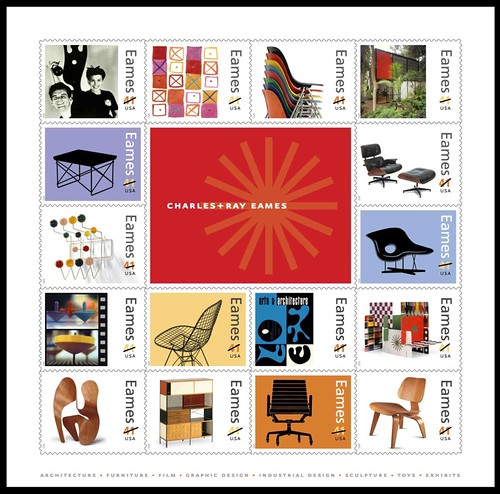After 10-years in the works, the Eames House, Lounge Chair, La Chaise, Crosspatch, House of Cards, and other famous Eames designs will get your mail from point A to point B this summer. More from the Chairman of the Board of the Eames Foundation.
About Jason Fried
Jason co-founded Basecamp back in 1999. He also co-authored REWORK, the New York Times bestselling book on running a "right-sized" business. Co-founded, co-authored... Can he do anything on his own?
In praise of lazy
“Whenever there is a hard job to be done I assign it to a lazy man; he is sure to find an easy way of doing it.” -Walter Chrysler
Flight Thru Instruments
Flight Thru Instruments is a US Navy pilot-training manual from the 40s designed by the Graphic Engineering Staff at General Motors. The information graphics are stunning, colorful, and clear.



Here’s the full Flickr set. Hat tip: Airbag.
Designing Interactions: Book recommendation
I got Designing Interactions over the holidays and have really enjoyed it so far. I’m not done with it, but I’m done enough to be able to recommend it.
The book looks at the evolution and breakthroughs of interface and industrial design over the last 40 odd years.
The history traces a squiggly line through the invention of the mouse, the graphical user interface, the PC, the laptop, the handheld, gaming, online services, the internet, and beyond. It’s a really interesting look at how this builds on that and that changes this.
The 700-page book is richly illustrated and includes interviews with some of the world’s most important figures in design, product development, design education, and computer science.
(Thanks for the book, JD)
Obama's victory speech
If you love speeches like I love speeches you’ll love Barack Obama’s Iowa victory speech. Wonderful words expertly delivered by perhaps the most gifted political orator of our generation. This speech soars.
Gene Lee says goodbye

Photo Credit: Jasmined
Anyone who spent time in Chicago’s Wicker Park over the last few years probably ran into Gene Lee “the dancing Asian guy.” Insert “weird” or “questionable fashion sense” at your discretion. Sadly, Gene recently passed away.
Gene was important because he represented an increasingly elusive burst of color and character. As our cities homogenize, our street corners fill with banks, and our old buildings are replaced by cookie cutter replicas of the uninspired cinderblock box next door, we’re reminded that it’s the people – especially the local characters – that flavor the city. Gene was one of those people.
Wicker Park has its share of street people and neighborhood fixtures. But most of them are ignored and fade into the chaos of cars, commuters, and city bustle. Gene, however, was impossible to ignore. It was fun to just watch people react to him. They didn’t look down, they didn’t just walk by, they didn’t ignore him—they smiled. They pointed and laughed too, but usually in a “hey, good for that guy!” kinda way. He cheered people up.
It’s so easy to go through your daily routine and never look at what’s going on around you. Gene snapped you out of that funk.
According to his brother, Gene was haunted by addiction and bipolar disorder. When he was dancing it was hard to tell if he was happy, miserable, or like most of us, somewhere in between. But he definitely made a lot of people smile. I hope that’s how he’s remembered.
Ask 37signals: How do you process credit cards?
Matt asks:
In my experience, credit card processing has been one of the major hurdles in starting an online business. Especially recurring/subscription charges.
You’ve got PayPal, which seems a little unprofessional (and is a pain in the a*), and an absurd number of 3rd party vendors offering various pieces of the puzzle. Integration is a pain, and the costs are really steep.
Can you offer any advice or guidance? When you were still small and just starting out with Basecamp, how did you tackle that?
I think I was a relatively early customer, and I was really impressed by how smooth and seamless the payment process was – it gave me a lot of confidence that I was buying a professional product, even though you hadn’t yet developed much of a name yet in the product world.
Many thanks for all that you contribute to the small business community – great products, great insights, and great inspiration.
First off, thanks for being an early customer. We have a special affinity for those who were willing to take a leap of faith and trust us in the early days. I know it’s hard to trust something new, so thanks.
So, credit card processing and set up and all that stuff is a real pain in the ass. It’s definitely intimidating to get started. The industry just feels dirty. So many companies offering merchant accounts, so many companies providing gateway software and integration, so many deals and discounts and conditions and terms and acronyms. What do we need? Who can we trust? How does it all work?
Some background
Before I get into how we’re set up now, I’ll tell you a little story about how we originally thought we’d be selling Basecamp.
We launched Basecamp back in February 2004. We were planning on launching in January, but we were held up because the sales method we originally wanted to go with was rejected by our merchant account provider.
At first we wanted to sell Basecamp with a flat yearly fee. $99/year, $149/year, $199/year. We thought it would be easier for customers to just pay once a year instead of every month. So we built the internals to support such a sales cycle.
However, when we explained our business to the company we picked to process our credit card transactions, they balked. They wouldn’t allow us to charge annually because we were unproven, we didn’t have a corporate credit history, and they didn’t really get the idea of subscription-based software. When we couldn’t provide a marketing brochure (didn’t have one), an annual report (didn’t have one), or anything “official” on paper (we still don’t have official letterhead stationary), I think they may have thought we were peddling porn.
The main issue was that if we went out of business in three months, they’d be left holding the risk of an annual subscription fee. So if someone paid us $149 in April for 12 months, and we went out of business in July, the merchant account company would be on the hook when the customer came calling for a refund. That wasn’t risk they were willing to take. I can’t say I blame them.
So we had to rejigger our entire business model. Instead of billing annually we had to switch to billing monthly. It turned out to be considerably more lucrative for us, and considerably more comfortable for our customers too. More revenue for us, lower cost of entry our customers. Instead of having to pony up $99 up front, they could pay $12/month for as long as they wanted. No contracts, no lock-in, no big initial investment on their part.
Today’s moving parts
Ok, so how do we do all this? First off, we have a merchant account. A merchant account is needed to accept credit cards. Every business that accepts credit cards needs to have a merchant account. We’ve used a few companies in the past, but currently we’re using an account provided by Chase bank. You should basically look for a reputable company you can trust that has good rates. The rates may not make all that much difference early on, but once your daily volume picks up a few basis points can make a big difference on your bottom line. But at first I’d pick trust over rates. You can always negotiate for better rates down the road.
Next we have an account with Authorize.net. Authorize.net is the gateway that our systems talk to. They take the credit card charge information from us, process the charge, and then deposit the money into our merchant account. If the charge doesn’t go through they send us a denial code which we then wordsmith and present to our customer.
The engine to process the recurring monthly charges is something we built custom. If you use Rails, Active Merchant would give you a good place to start. We don’t use Active Merchant because we built our stuff before AM was released, but it’s definitely a nice library.
Every night the system scans the paying accounts for each product and determines which ones are due for a charge. We then submit the charges one by one and record the result.
If the charge was successful we shoot off an paid invoice to the customer via email. If the charge was declined we shoot them an email with the explanation. We then try the declined card again three days later and then another three days after that if it was declined a second time. The customer’s account remains open while we attempt to process the charge. If the charge was declined three times we freeze the account until the customer is able to provide a valid credit card number.
The one thing we’re often surprised by is how many accounts have charge issues so it’s important to really think about the error handling and customer experience issues related to declined cards. Freezing an account too fast is unfair, but it’s also important to put a limit on your goodwill. We’ve gotten better at this over time, but the sheer number of charge errors initially caught us off guard. It’s not fraud, it’s just things like expired cards, credit limits, corporate charge policies, etc.
We’ve also recently started a major conversion of our internal systems to a centralized billing system. In the past each product had its own internal billing engine. Today we’re centralizing this. We’re essentially building an internal web service that our other products can talk to when they need to charge a card. They ping the service with the details and the central system takes care of the rest. This is much cleaner and much easier to maintain since we only have to deal with processing in one place. Other benefits will come from this centralization down the road.
Did that help?
I hope this provides at least a basic understanding of the fundamental moving parts and how we bill our customers. If you have other questions please post them in the comments section and we’ll try to answer what we can.
Got a question for us?
Got a question about design, business, marketing, etc? We’re happy to try to provide some insight into how we’d tackle the problem. Just email svn [at] 37signals dot com with the subject “Ask 37signals”. Thanks.
SEED almost sold out
Along with Jim Coudal of Coudal Partners and Carlos Segura of Segura Inc. and T.26, we’re again presenting a one-day conference on design, entrepreneurship and inspiration on Chicago’s IIT Campus. The date is Friday, January 18th.
We’ve sold over 120 seats so far so there are just a couple dozen left. For more on what it’s all about, check Mike Rohde’s illustrated notes from the first Seed and a couple reviews too. And this guy is going to SEED instead of MacWorld.
Ask 37signals: Numbers?
Rich asks:
Without revealing any financials or numbers from which financials could be derived, could you satisfy the geek curiosity in me and share a few details from 37 Signals apps? Number of customers, contacts, projects, milestones, files on S3, number of servers, logical infrastructure topology, etc.
Here are some rough numbers we can share:
Basecamp
- 2,000,000 people with accounts
- 1,340,000 projects
- 13,200,000 to-do items
- 9,200,000 messages
- 12,200,000 comments
- 5,500,000 time tracking entries
- 4,000,000 milestones
Highrise
- 3,500,000 contacts
- 1,200,000 notes/comments
- 575,000 tasks
Backpack
- Just under 1,000,000 pages
- 6,800,000 to-do items
- 1,500,000 notes
- 829,000 photos
- 370,000 files
Campfire
- 130,000 rooms
- 46,000,000 chat messages
- 200,000 files shared
Overall storage stats (Nov 2007)
- 5.9 terabytes of customer-uploaded files
- 888 GB files uploaded (900,000 requests)
- 2 TB files downloaded (8,500,000 requests)
Server stuff
We’re currently upgrading our server infrastructure to use significantly faster hardware along with the Xen virtualization software, so we’ll have fewer servers to manage. Our current server cluster contains around 30 machines, ranging from single processor file servers to 8 CPU application servers, for a total of around 100 CPUs and 200GB of RAM. Over the next couple of months, we plan to reduce the number of servers to 16 with around 92 CPU cores (each significantly faster than what we use today) and around 230 GB of combined RAM. Not only will our applications run faster, but our cluster will be much simpler to manage when we’re done.
Got a question for us?
Email svn at 37signals dot com and title the email “Ask 37signals”. Thanks!
Where did the intranets go?
The last few years has seen a proliferation of web-app development. Lots of productivity tools, to-do lists, online word processors and spreadsheets, presentation tools, groupware, calendars, etc. Lots of business software.
Noticeably absent are dedicated intranet tools. Software to help businesses get their shit together internally. A place to post common information, to have discussions, to share files, and possibly to share a calendar or important dates. There are definitely products out there, but this market doesn’t seem to have seen the same level of development as other business software.
When we were still doing client work back in the early 2000s we got a lot of calls about designing intranets. Everyone wanted an intranet. The employees we talked to loved their intranets too—their jobs depended on having access to bits of information, files, forms, etc. that were only available on their company intranet.
But since then I haven’t heard much noise from the intranet camp. Have people given up because the options were too complicated? Or have they built their own? Or are they piecing together blogs and wikis and file storage services and online calendars to get the job done?
What does your company or group use to keep your information together, centralized, and accessible to people you work with? Are you using something home grown? Something off the shelf? Something old? Something new? We’re curious.



